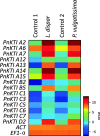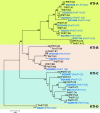Poplar protease inhibitor expression differs in an herbivore specific manner
- PMID: 33836664
- PMCID: PMC8033671
- DOI: 10.1186/s12870-021-02936-4
Poplar protease inhibitor expression differs in an herbivore specific manner
Abstract
Background: Protease inhibitors are defense proteins widely distributed in the plant kingdom. By reducing the activity of digestive enzymes in insect guts, they reduce the availability of nutrients and thus impair the growth and development of the attacking herbivore. One well-characterized class of protease inhibitors are Kunitz-type trypsin inhibitors (KTIs), which have been described in various plant species, including Populus spp. Long-lived woody perennials like poplar trees encounter a huge diversity of herbivores, but the specificity of tree defenses towards different herbivore species is hardly studied. We therefore aimed to investigate the induction of KTIs in black poplar (P. nigra) leaves upon herbivory by three different chewing herbivores, Lymantria dispar and Amata mogadorensis caterpillars, and Phratora vulgatissima beetles.
Results: We identified and generated full-length cDNA sequences of 17 KTIs that are upregulated upon herbivory in black poplar leaves, and analyzed the expression patterns of the eight most up-regulated KTIs via qRT-PCR. We found that beetles elicited higher transcriptional induction of KTIs than caterpillars, and that both caterpillar species induced similar KTI expression levels. Furthermore, KTI expression strongly correlated with the trypsin-inhibiting activity in the herbivore-damaged leaves, but was not dependent on damage severity, i.e. leaf area loss, for most of the genes.
Conclusions: We conclude that the induction of KTIs in black poplar is controlled at the transcriptional level in a threshold-based manner and is strongly influenced by the species identity of the herbivore. However, the underlying molecular mechanisms and ecological consequences of these patterns remain to be investigated.
Keywords: Coleoptera; Induced defenses; Kunitz-type trypsin inhibitors; herbivore specificity; woody plants; tree defenses; Lepidoptera; Proteinase inhibitors; Salicaceae.
Conflict of interest statement
The authors declare that they have no competing interests.
Figures




Similar articles
-
Specificity of Herbivore Defense Responses in a Woody Plant, Black Poplar (Populus nigra).J Chem Ecol. 2019 Feb;45(2):162-177. doi: 10.1007/s10886-019-01050-y. Epub 2019 Feb 21. J Chem Ecol. 2019. PMID: 30788656 Free PMC article.
-
Beetle feeding induces a different volatile emission pattern from black poplar foliage than caterpillar herbivory.Plant Signal Behav. 2015;10(3):e987522. doi: 10.4161/15592324.2014.987522. Plant Signal Behav. 2015. PMID: 25831045 Free PMC article.
-
Functional analysis of the Kunitz trypsin inhibitor family in poplar reveals biochemical diversity and multiplicity in defense against herbivores.Plant Physiol. 2008 Mar;146(3):888-903. doi: 10.1104/pp.107.106229. Epub 2007 Nov 16. Plant Physiol. 2008. PMID: 18024557 Free PMC article.
-
Proteinase inhibitors in legume herbivore defense: from natural to genetically engineered protectants.Plant Cell Rep. 2022 Feb;41(2):293-305. doi: 10.1007/s00299-021-02800-7. Epub 2021 Oct 21. Plant Cell Rep. 2022. PMID: 34674016 Review.
-
Integrated view of plant metabolic defense with particular focus on chewing herbivores.J Integr Plant Biol. 2022 Feb;64(2):449-475. doi: 10.1111/jipb.13204. J Integr Plant Biol. 2022. PMID: 34914192 Review.
Cited by
-
NaMLP, a new identified Kunitz trypsin inhibitor regulated synergistically by JA and ethylene, confers Spodoptera litura resistance in Nicotiana attenuata.Plant Cell Rep. 2023 Apr;42(4):723-734. doi: 10.1007/s00299-023-02986-y. Epub 2023 Feb 6. Plant Cell Rep. 2023. PMID: 36740647
-
Midgut serine proteinases participate in dietary adaptations of the castor (Eri) silkworm Samia ricini Anderson transferred from Ricinus communis to an ancestral host, Ailanthus excelsa Roxb.Front Insect Sci. 2023 Aug 10;3:1169596. doi: 10.3389/finsc.2023.1169596. eCollection 2023. Front Insect Sci. 2023. PMID: 38469493 Free PMC article.
-
Proteolytic and Structural Changes in Rye and Triticale Roots under Aluminum Stress.Cells. 2021 Nov 5;10(11):3046. doi: 10.3390/cells10113046. Cells. 2021. PMID: 34831267 Free PMC article.
-
Combined -omics framework reveals how ant symbionts benefit the Neotropical ant-plant Tococa quadrialata at different levels.iScience. 2022 Oct 2;25(10):105261. doi: 10.1016/j.isci.2022.105261. eCollection 2022 Oct 21. iScience. 2022. PMID: 36274949 Free PMC article.
References
-
- Boeckler GA, Towns M, Unsicker SB, Mellway RD, Yip L, Hilke I, et al. Transgenic upregulation of the condensed tannin pathway in poplar leads to a dramatic shift in leaf palatability for two tree-feeding Lepidoptera. J Chem Ecol. 2014;40(2):150–8. 10.1007/s10886-014-0383-7. - PubMed
MeSH terms
Substances
LinkOut - more resources
Full Text Sources
Other Literature Sources
Miscellaneous

